Nestled amongst the thickly forested hills and valleys eight miles southeast of Ponoka are the Chain Lakes, a peaceful and natural setting that was likely the aftermath of the glacier age. These three narrow, deep and cold lakes are special and picturesque, set in a narrow valley and surrounded by steep wooded mountain-like banks and cliffs.
The historical name Chain Lakes likely came from the fact that the three bodies of water are joined together by narrow waterways that from above resemble the links of a chain.
The early history of the area tells of much travel along the Nebraska Trail, a rugged early Indian path that stretched from the tribal settlements at Buffalo Lake and wound across the countryside to Donavan crossing and toward Ponoka. Densely surrounded by a wide variety of trees, plants, rare orchids and other flowers, and fed by several streams, the pristine Chain Lakes were always teaming with fish, and visited regularly by the likes of beaver, white-tail and mule deer, moose, small mammals and numerous species of birds and water fowl.
Mr. Sausen was the first settler to claim a homestead in what would eventually be known as the Scott district, and many generations and newcomers would follow.
Some of the founding families of the early settlement of the Chain Lakes area would include: the Trumans, Huscrofts, Jones, Algars, Stoutenbergs, Bures, Donovans, Owens, Scotts and Colemans. Ponoka’s first Physician, Dr. Angus Alexander Drinnan set up his practise here in 1902, and was so impressed by the beauty of Chain Lakes that he built a palatial home and fox farm overlooking the valley. No matter where his career took him, the Drinnan family would always return to the serene sight for many decades to enjoy bountiful fishing, recreation and relaxation.
The first school was built in the area in 1902, and with the family farming settlement growing quickly, Chain Lakes would also become a popular year-round recreational playground for residents and visitors. Most nice weekends in the summer would feature many folks of all ages arriving in cars, buggies, or on horseback with their picnic baskets or camping gear to enjoy fishing and swimming, as well as games of ball, horseshoes, or other activities. In the winter there was always lots of sledding, skating, ice fishing, as well as numerous late night events warmed by a roaring bonfire. The only access to the lakes in the early days was through Mr. Rook’s farmyard and down a narrow path which he had built with pick and shovel down to the water’s edge.
For many years it was a treat to see Ponoka machine shop owner Herb Rees arrive with his big sheet metal boat, powered by a Model T Ford motor, and giving thrilling fast rides around the lakes. Mrs. Truman recalled going with a church group to the lake for their annual baptismal service. This pristine spot was always the perfect spot for family and wedding photos, or special occasions. In the 1960s the Alberta Mental Health Association established Lake Eden between the first and second lakes, which served for many decades as a delightful camping and activity centre for patients and staff of the Ponoka and Oliver hospitals.
The historical beauty and secrets of Chain Lakes
This magnificent region has quite often been referred to as one of the best kept secrets in Alberta, and while its amenities are many, they are also very delicate, and need to be protected and maintained for future generations. For many decades the three-lake system has been fed by underground natural springs that have come from long distances around the area into all sides of the lakes. Within a three-mile radius there are also sizable ponds to be found year round that are also replenished by the fresh water streams and help to maintain the water needs and drainage source for many of the residents who make their homes there.
These bodies of water, which were carved out of the muskeg over many centuries, have also created a series of floating sedge and willow fens and marshes. Not only are these a natural pollution fighter, they are also the ideal homes and habitat for thousands of breeding pairs of duck, geese, occasional white swans and species of wildlife.
The rugged canyons, valleys, and rock formations around Chain Lakes have been created by time, spring run-off, and rains, and present not only a wonderful opportunity for exploring on foot or on horseback, but also feature such delightful surprises as numerous waterfalls and many species of birds and small animals nesting within their walls.
Both the Lacombe and Ponoka Fish and Game Association own recreational land rights around these lakes, and their goals have been not only to continue to provide a special playground for all ages, but also to maintain and protect the precarious natural environment and active wildlife activity.
While several property owners have applied for watershed protection, the Friends of Chain Lakes has also been formed, and will work very closely with present and new landowners, Ponoka County and municipal groups to conserve this peaceful natural playground for the enjoyment of future generations.
